

Abdeen Palace. Abdeen Palace (Arabic: قصر عابدين) is a historic Cairo palace, and one of the official residences and the principal workplace of the President of Egypt, located above Qasr el-Nil Street in eastern Downtown Cairo, Egypt. Overview[edit] Built on the site of a small mansion owned by Abidin Bey, Abdeen Palace, which is named after him, is considered one of the most sumptuous palaces in the world in terms of its adornments, paintings, and large number of clocks scattered in the parlors and wings, most of which are decorated with pure gold.
Built by Khedive Ismail, to become the official government headquarters instead of the Citadel of Cairo (which had been the centre of Egyptian government since the Middle Ages), this palace was used as well for official events and ceremonies. Construction started in 1863 and continued for 10 years and the palace was officially inaugurated in 1874. Museum[edit] See also[edit] Abdeen Palace Incident of 1942 References[edit] External links[edit] Coordinates: Heliopolis travel guide. Baron Empain Palace in Heliopolis Heliopolis (مصر الجديدة Masr el-Gedida, lit. "New Cairo") is one of the nicest places to live in Cairo, but there isn't much to visit as a tourist. Midan Tahrir travel guide. Midan Tahrir Midan Tahrir (Arabicميدان التحرير, "Liberation Square", also commonly known as Tahrir Square) is the name given to the large public square at the epicentre of modern Cairo and, as a city district, to the streets and institutions located nearby.
The Egyptian Museum, the American University in Cairo, the Arab League and the Hilton and Intercontinental Hotels are all located within this district, as are several important government offices (including those for the renewal of visas). The metro also has its main nexus under Midan Tahrir, and a great many buses and taxis make Tahrir Square a key part of their services. Gayer-Anderson Museum. Roof terrace of the Gayer-Anderson Museum The Gayer-Anderson Museum is located in Cairo, Egypt, adjacent to the Mosque of Ahmad ibn Tulun in the Sayyida Zeinab neighborhood.
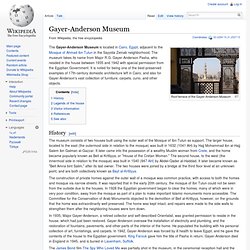
The museum takes its name from Major R.G. Gayer-Anderson Pasha, who resided in the house between 1935 and 1942 with special permission from the Egyptian Government. It is noted for being one of the best-preserved examples of 17th-century domestic architecture left in Cairo, and also for Gayer-Anderson's vast collection of furniture, carpets, curio, and other objects. Al-Azhar Mosque. Al-Azhar Mosque (Arabic: الجامع الأزهر al-Gāmi` al-Azhar, "mosque of the most resplendent") is a mosque in Islamic Cairo in Egypt.

Al-Mu‘izz li-Dīn Allāh of the Fatimid Caliphate commissioned its construction for the newly established capital city in 970. Its name is usually thought to allude to the Islamic prophet Muhammad's daughter Fatimah, a revered figure in Islam who was given the title az-Zahrā′ ("the shining one"). Juyushi Mosque. Juyushi Mosque (Arabic: الجامع الجيوشى "Mosque of the Armies") was built by Badr al-Jamali who was "Amir al-Juyush" (امير الجيوش "Commander of the Armies") for the Fatimid Caliphate.
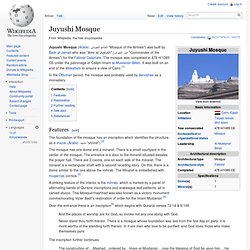
The mosque was completed in 478 H/1085 CE under the patronage of Caliph-Imam al-Mustansir Billah. Lulua Mosque. The Lulua Mosque (Arabic: مسجد لؤلؤة) (meaning:the Pearl) is a mosque in Cairo, Egypt, that was built in 1015–16 AD.

Al-Hakim Mosque. Al-Jam`e Al-Anwar (Arabic: الجامع الانور, Anwar Mosque, literally:The Enlightened Mosque) also Al-Hakim Mosque is a major Islamic religious site in Cairo, Egypt.
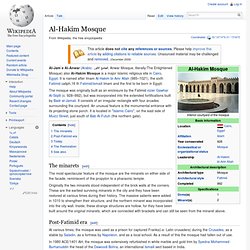
It is named after Imam Al-Hakim bi-Amr Allah (985–1021), the sixth Fatimid caliph,16 th Fatimid/Ismaili Imam and the first to be born in Egypt. The mosque was originally built as an enclosure by the Fatimid vizier Gawhar Al-Siqilli (c. 928–992), but was incorporated into the extended fortifications built by Badr al-Jamali. It consists of an irregular rectangle with four arcades surrounding the courtyard. An unusual feature is the monumental entrance with its projecting stone porch. Khan el-Khalili. Khan el-Khalili, Bab al-Ghuri.
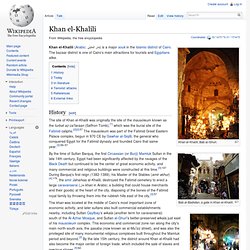
Bab al-Badistan, a gate in Khan el-Khalili. An old chandeliers shop at Khan el-Khalili. Cairo Tower. The Cairo Tower (Arabic: برج القاهرة, Borg Al-Qāhira) is a free-standing concrete tower located in Cairo, Egypt.
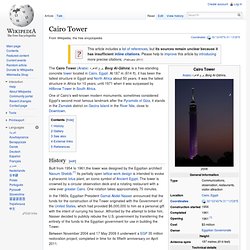
At 187 m (614 ft), it has been the tallest structure in Egypt and North Africa about 50 years. It was the tallest structure in Africa for 10 years, until 1971 when it was surpassed by Hillbrow Tower in South Africa. One of Cairo's well-known modern monuments, sometimes considered Egypt's second most famous landmark after the Pyramids of Giza, it stands in the Zamalek district on Gezira Island in the River Nile, close to Downtown. History[edit] Built from 1954 to 1961,the tower was designed by the Egyptian architect Naoum Shebib.[1] Its partially open lattice-work design is intended to evoke a pharaonic lotus plant, an iconic symbol of Ancient Egypt. Between November 2004 and 17 May 2009 it underwent a EGP 35 million restoration project, completed in time for its fiftieth anniversary on April 2011.
Gallery[edit] See also[edit] External links[edit] Egyptian Museum. The Museum of Egyptian Antiquities, known commonly as the Egyptian Museum or Museum of Cairo, in Cairo, Egypt, is home to an extensive collection of ancient Egyptian antiquities.

It has 120,000 items, with a representative amount on display, the remainder in storerooms. History[edit] The Egyptian Museum of Antiquities contains many important pieces of ancient Egyptian history. It houses the world’s largest collection of Pharaonic antiquities, and many treasures of King Tutankhamen. Cairo. Cairo (/ˈkaɪroʊ/ KYE-roh ; Arabic: القاهرة) is the capital of Egypt and the largest city in the Middle-East and Africa.
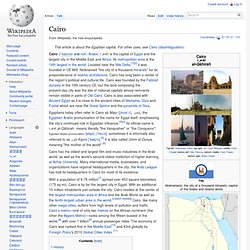
Its metropolitan area is the 16th largest in the world. Located near the Nile Delta,[1][2] it was founded in CE 969. Nicknamed "the city of a thousand minarets" for its preponderance of Islamic architecture, Cairo has long been a center of the region's political and cultural life. Old Cairo. Old Cairo (Egyptian Arabic: Masr el Adīma) is a part of Cairo, Egypt, that contains the remnants of those cities which were capitals before Cairo, such as Fustat, as well as some other elements from the city's varied history.
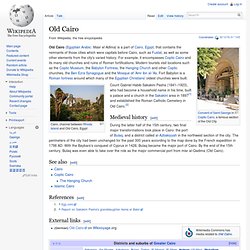
For example, it encompasses Coptic Cairo and its many old churches and ruins of Roman fortifications. Modern tourists visit locations such as the Coptic Museum, the Babylon Fortress, the Hanging Church and other Coptic churches, the Ben Ezra Synagogue and the Mosque of 'Amr ibn al-'As. Fort Babylon is a Roman fortress around which many of the Egyptian Christians' oldest churches were built. Count Gabriel Habib Sakakini Pasha (1841–1923), who had become a household name in his time, built a palace and a church in the Sakakini area in 1897[1] and established the Roman Catholic Cemetery in Old Cairo.[2] Medieval history[edit] See also[edit] References[edit] External links[edit] (German) Old Cairo on Wikivoyage.org Coordinates:
Fatimid Caliphate. Sunni Islam. Sunni Islam (/ˈsuːni/ or /ˈsʊni/) is the largest branch of Islam; its adherents are referred to in Arabic as ahl as-sunnah wa l-jamāʻah (Arabic: أهل السنة والجماعة), "people of the tradition of Muhammad and the consensus of the Ummah" or ahl as-sunnah (أهل السنة) for short. In English, they are known as Sunni Muslims, Sunnis, and Sunnites. Sunni Islam is the world's largest religious body[1] and largest religious denomination for any religion in the world. Sunni Islam is sometimes referred to as the orthodox version of the religion.[2][3] The word "Sunni" is believed to come from the term Sunnah (Arabic: سنة), which refers to the sayings and actions of the prophet Muhammad as recorded in hadiths.[4] Shia Islam. The Shia (Arabic: شيعة Shīʿah) represent the second largest denomination of Islam and adherents of Shia Islam are called Shias or the Shi'a as a collective or Shi'i individually.[1] Shi'a is the short form of the historic phrase Shīʻatu ʻAlī (شيعة علي) meaning "followers", "faction" or "party" of Muhammad's son-in-law and cousin Ali, whom the Shia believe to be Muhammad's successor in the Caliphate.
Twelver Shia (Ithnā'ashariyyah) is the largest branch of Shia Islam and the term Shia Muslim is often taken to refer to Twelvers by default. Shia Muslims constitute 10-20% of the world's Muslim population and 38% of the Middle East's entire population.[2] Although there are myriad Shi'i subsects, modern Shi'i Islam has been divided into three main groupings: Twelvers, Ismailis and Zaidis.[6][7][8][9] Things to do in Cairo. Historical Weather for Cairo, Egypt - Travel, Vacation, Forecast and Reference Information.
Nearby Ruins. Places to Stay.